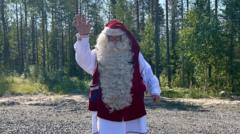As temperatures in Lapland soar to unusual highs, Santa Claus finds himself managing a heatwave far from the snowy wonderland typically associated with his North Pole workshop. In Rovaniemi, northern Finland, prolonged spells of heat have pushed the mercury to around 30°C (86°F), a stark contrast to the usual cool temperatures of the Arctic.
With the summer sun beating down relentlessly, Santa is taking extra precautions to ensure the well-being of his reindeer and his dedicated team of elves. "Ensure the reindeer stay hydrated and drink a glass of water every hour," he advises, adapting to an unprecedented situation. This is a far cry from the winter wonderland with which he is typically associated.
The recent heatwave has persisted for over 15 days, raising alarms about its implications for the Arctic climate. According to Jaakko Savela from the Finnish Meteorological Institute, "this heatwave is exceptional for Lapland," with temperatures reaching 31.7°C (88.1°F), marking a significant rise compared to the area’s typical summer norms.
While experts like Savela and Professor Jeff Weller of the University of the Arctic illustrate the troubling implications of climate change on the Arctic, they clarify that the lengthy heatwave has not been solely caused by climate change. However, they agree that without human-induced climate shifts, the temperatures would surely have been lower.
The animal life native to Lapland is not immune to the effects of the heat. Reindeer, known for their crucial role in Lapland's cultural heritage, are now seeking relief from rising mosquito populations due to the warm weather. As they venture closer to human habitation seeking cooler air, concerns arise about their future and the potential need for herders to create sheltered spaces for them.
Tourists flocking to Lapland are equally bewildered by the sudden rise in temperatures. "I came here to escape the heat and instead I’m boiling," shared Silvia from Prague, who was unprepared for the intense warmth and admitted to packing inadequately for the climate.
As the sun shines for over 20 hours a day in Rovaniemi, visitors are left feeling out of place in what they envisioned as a cold, winter escapes. For Elina, an elf at Santa’s post office, mounting heatwaves give way to reflections on climate worries: "Are heatwaves becoming the new standard for our summers?"
For Santa, even this season’s attire presents challenges; his iconic red suit is not designed for warmth. "I’m only comfortable outdoors after the sun goes down," he admits, longing for the cold, snowy winters that have historically defined his festive homeland. "For me, winter is when I thrive."
As Lapland adapts to these changing conditions, both the beloved icon and nature’s inhabitants wrestle with the emerging reality of a warming planet.
With the summer sun beating down relentlessly, Santa is taking extra precautions to ensure the well-being of his reindeer and his dedicated team of elves. "Ensure the reindeer stay hydrated and drink a glass of water every hour," he advises, adapting to an unprecedented situation. This is a far cry from the winter wonderland with which he is typically associated.
The recent heatwave has persisted for over 15 days, raising alarms about its implications for the Arctic climate. According to Jaakko Savela from the Finnish Meteorological Institute, "this heatwave is exceptional for Lapland," with temperatures reaching 31.7°C (88.1°F), marking a significant rise compared to the area’s typical summer norms.
While experts like Savela and Professor Jeff Weller of the University of the Arctic illustrate the troubling implications of climate change on the Arctic, they clarify that the lengthy heatwave has not been solely caused by climate change. However, they agree that without human-induced climate shifts, the temperatures would surely have been lower.
The animal life native to Lapland is not immune to the effects of the heat. Reindeer, known for their crucial role in Lapland's cultural heritage, are now seeking relief from rising mosquito populations due to the warm weather. As they venture closer to human habitation seeking cooler air, concerns arise about their future and the potential need for herders to create sheltered spaces for them.
Tourists flocking to Lapland are equally bewildered by the sudden rise in temperatures. "I came here to escape the heat and instead I’m boiling," shared Silvia from Prague, who was unprepared for the intense warmth and admitted to packing inadequately for the climate.
As the sun shines for over 20 hours a day in Rovaniemi, visitors are left feeling out of place in what they envisioned as a cold, winter escapes. For Elina, an elf at Santa’s post office, mounting heatwaves give way to reflections on climate worries: "Are heatwaves becoming the new standard for our summers?"
For Santa, even this season’s attire presents challenges; his iconic red suit is not designed for warmth. "I’m only comfortable outdoors after the sun goes down," he admits, longing for the cold, snowy winters that have historically defined his festive homeland. "For me, winter is when I thrive."
As Lapland adapts to these changing conditions, both the beloved icon and nature’s inhabitants wrestle with the emerging reality of a warming planet.




















